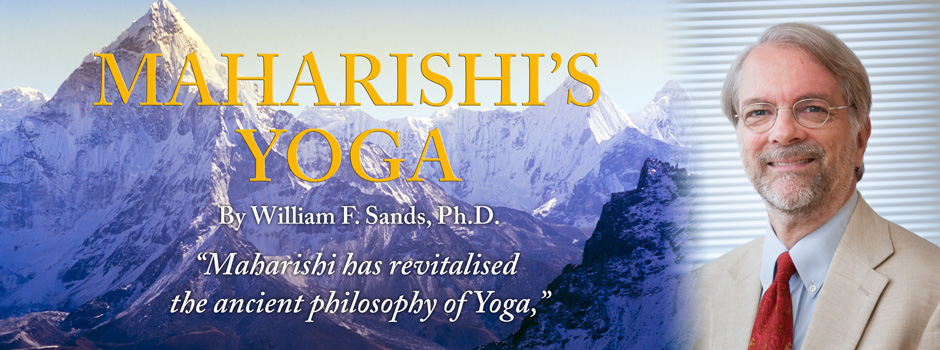This – let me say at the outset – is an absolutely delightful, profound, insightful and extremely well-written book which will appeal to anyone practising Transcendental Meditation and anyone attending the Yoga classes so much in vogue nowadays.
To many in the west, Yoga is just an ancient form of exercise, practised for its health benefits. Even as such it is one of the fastest growing health trends in the world, renowned for its ability to keep the body flexible and toned. It brings a wide range of benefits including strengthening the heart, and improving concentration, memory and learning ability.
Yet, says Sands, as Maharishi has revealed there is much more to Yoga than that. Maharishi has brought about a revival of knowledge that has restored its full significance for guiding us on the path to enlightenment.
“Quietly waiting behind the generic term Yoga is a comprehensive philosophy and an array of techniques and procedures for unlocking the untapped potential that is said to be inside us all,” writes Sands.
Directly experiencing this infinite intelligence on a daily basis is where Transcendental Meditation comes in, he explains.
The Maharishi Yoga Asanas, or postures, also have an integral role to play, helping to achieve the physiological balance and integration of mind and body that characterise enlightenment.
Bhagavad-Gita
Sands lays the ground for a discussion of Yoga by turning to Maharishi’s translation and commentary on the Bhagavad-Gita, “one of the most important and widely read texts on Yoga philosophy”.
In the Gita, the hero, Arjuna, asks his charioteer, Lord Krishna, for advice on a forthcoming battle where the call of duty requires him to fight friends and family – a dilemma that he finds insoluble.
“All other Yoga texts are elaborations on the simple formula that Lord Krishna gave Arjuna in the moments before battle,” says Sands. It’s worth quoting at length how he reports on Maharishi’s interpretation of Lord Krishna’s advice to Arjuna, as it gives a flavour of the clarity with which this book is written.
Lord Krishna told Arjuna to “be without the three gunas” – advice which at first glance seems to have little to do with the coming battle.
Explains Sands: “In the Vedic understanding, the three gunas are the most fundamental forces of nature, responsible for everything that takes place in our lives and in our environment. Indeed, the whole universe is said to emerge from their interplay. Be without the three gunas, therefore, advises Arjuna to go beyond the material universe, to something that is more fundamental than even these most basic laws of nature.
“What can that possibly mean? How can one go beyond the material universe?
“Most modern commentators suggest that Lord Krishna wanted Arjuna to adjust his attitude – to become more dispassionate and feel less attached to the events and people around him. In this way he would not feel bound to the material world, and would (supposedly) feel better about entering into battle. But this is a critically wrong interpretation, which in Maharishi’s view undermines the entire teaching of the Gita. For aren’t you still very much within the influence of the gunas when you create a mood of non-attachment? Aren’t you still thinking thoughts and engaging in actions, and therefore still operating within the universe as we know it?
“Furthermore, changing your attitude can be somewhat pointless, for it doesn’t alter your nature or your current situation. Doing so would be roughly analogous to a poor person pretending to be rich. Regardless of attitude there would still be neither money nor purchasing power, and one might even be considered to be delusional. In the final analysis, there would be nothing to show for one’s efforts other than a mood that probably won’t last. And, as Maharishi points out, trying to create a mental state that is contrary to the realities of life is weakening to the mind and may cause a lack of integration.
“So what was Lord Krishna advising Arjuna to do?
“Maharishi’s answer is central to his analysis of Yoga philosophy and provides a framework through which we can understand what Yoga is truly about. He explains that the most fundamental level of nature’s functioning – beyond material structures and forms, beyond the three gunas – is an infinite field of pure intelligence.”
Thus, explains Sands, “when Lord Krishna recommended to Arjuna that he be without the three gunas, he wasn’t suggesting a mood or a philosophy – he was quite literally directing him toward this transcendental reality.”
Yoga & union
nbounded awareness is described by many names in the Vedic texts. One is ‘Yoga’.
“Yoga,” says Sands, “is derived from a Sanskrit verb meaning to yoke or to join, and is defined as the union, or joining, of individual awareness with its source, pure consciousness – infinite, unbounded, pure Being.”
And, as he later explains, “anyone can experience Yoga by using techniques that are in the Yoga tradition. The texts themselves are not ‘how-to-manuals’, because learning the procedures for going within requires careful attention from a teacher trained to give the correct instruction for every student’s nervous system and experience. For this reason, what Maharishi calls the ‘technologies of consciousness’ are always taught in person, one-to-one, as they have been for millennia.”
The discussion moves to how the Yoga texts have been interpreted once these ‘technologies of consciousness’ were forgotten millennia ago.
Left only with the texts and descriptions of enlightenment but no means to gain the experience, custodians of the Yoga tradition, perhaps not surprisingly, put the cart firmly before the horse. Descriptions of the goal were taken to be prescriptions for the path, with dire consequences for the purity, accuracy and effectiveness of the teachings.
Misunderstandings
Without the experience of pure consciousness, other mistaken notions creep in about what the Yoga texts are referring to. “Eliminating desires” is one such idea. The notion became prevalent in some schools of Yoga that somehow we should not enjoy sensory experience and should try to maintain an attitude of equanimity in the face of the so-called pairs of opposites (pleasure and pain, happiness and sorrow, success and failure, etc). Yet, as Sands points out, Maharishi held a very different view – that desire is natural to life, impossible to eradicate, and that, in Maharishi’s words, “any attempt in that direction will only make life dull, useless or tense”.
Maharishi’s view, Sands relates, is that desire has a crucial role. “Our desires constantly propel us toward more and more – more success, happiness and fulfilment. This tendency for greater happiness enables us to settle deep within during Transcendental Meditation practice, and it also underlies our pursuit of higher states of consciousness.”
Maharishi does point out that desires can keep us bound to the field of action simply because there is nothing in the relative, changing world that can satisfy every desire.
Maharishi’s solution, Sands reports, is “to rise above the binding influence of desires, not by forcibly inhibiting them, but by establishing the awareness in Being, the field of pure happiness in which all desires find fulfilment”.
Similarly fascinating re-interpretations of other supposed guidelines for activity or attitude are described, including “freedom from possessions”, “maintaining equanimity”, “renunciation”, and “Self-remembering”, all with relevant Yoga texts and Maharishi’s explanations of how they actually all refer to the natural experiences of higher states of consciousness – rather than prescriptions for behaviour.
The “Eight Limbs of Yoga” – Yama, Niyama, Asana, Pranayama, Pratyahara, Dharana, Dhyana, and Samadhi – are also covered, along with Maharishi’s explanations of how each can be seen in its full value when interpreted in the light of the experience of pure consciousness. Likewise with the different systems of Yoga – Karma Yoga, Gyan Yoga, Bhakti Yoga and Raja Yoga – with each insight seeming more fascinating than the last.
Yoga in human physiology
Finally, Sands outlines the findings of Dr Tony Nader, MD, PhD, whom Maharishi appointed to lead his worldwide organisation and recognised with the title of Maharaja Adhiraj Rajaraam. Under Maharishi’s guidance, Dr Nader has discovered a perfect correspondence between the forty principal aspects of the human body and the forty aspects of Vedic literature, in both structure and function.
Sands reminds us that Yoga means union. Dr Nader, he reports, located the expression of the Yoga Sutras in the human body as being the association fibres in the cerebral cortex, axons of neurons which unite different parts of the cerebral hemisphere. “The total number of association fibres can be divided into 195 sets, which correspond to the 195 sutras of the Yoga Sutra,” reports Sands. “Dr Nader further found a correspondence between the dimensions of the brain area and the length of the sutras: the longer sutras correspond to larger areas of the cortex, and the shorter sutras to smaller areas.”
“Maharishi has revitalised the ancient philosophy of Yoga,” summarises Sands. “He has rescued it from the mire of mysticism and restored it to its proper place in human life – as an effortless, natural science and technology of human evolution, at once ancient and yet thoroughly modern. With this great revival of knowledge, every individual has the master key to restore the true dignity of human life.”
Maharishi’s Yoga is available from Maharishi Ayurveda Products. Reproduction of an original article from Transcendental Meditation News.






